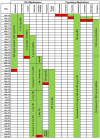Challenges in the Treatment of Restless Legs Syndrome: A Case Report
- PMID: 34032164
- PMCID: PMC8155758
- DOI: 10.1177/21501327211019590
Challenges in the Treatment of Restless Legs Syndrome: A Case Report
Abstract
Treatment resistant restless legs syndrome (RLS) in the setting of psychiatric comorbidities can be difficult to manage. Our patient is a 69-year-old Caucasian gentleman with bipolar disorder type I, unspecified anxiety disorder, obstructive sleep apnea (OSA), and treatment-refractory RLS. At initial presentation, the patient's prescribed medication regimen included fluoxetine 40 mg daily, gabapentin 800 mg in the morning and 3200 mg at bedtime, pramipexole 0.375 mg daily, lamotrigine 200 mg daily, trazodone 200 mg at bedtime, and temazepam 15 to 30 mg as needed for insomnia and RLS. Over the course of nearly 4 years, treatment interventions for this patient's RLS included: cognitive behavioral therapy for insomnia, discontinuation of exacerbating medications, switching dopamine agonists, use of pregabalin and iron supplement. This report demonstrates a challenging case of RLS in the setting of psychiatric comorbidities, development of augmentation, and polypharmacy.
Keywords: case report; medications; mood disorder; psychiatry; restless legs.
Conflict of interest statement
Similar articles
-
[Sleep disorders in patients with a neurocognitive disorder].Encephale. 2022 Jun;48(3):325-334. doi: 10.1016/j.encep.2021.08.014. Epub 2021 Dec 14. Encephale. 2022. PMID: 34916075 Review. French.
-
Treating Severe Refractory and Augmented Restless Legs Syndrome.Chest. 2022 Sep;162(3):693-700. doi: 10.1016/j.chest.2022.05.014. Epub 2022 May 21. Chest. 2022. PMID: 35609673 Review.
-
Restless legs syndrome: pathophysiology and modern management.Postgrad Med J. 2013 Jul;89(1053):402-10. doi: 10.1136/postgradmedj-2012-131634. Epub 2013 Mar 22. Postgrad Med J. 2013. PMID: 23524988 Review.
-
Pharmacotherapy for restless legs syndrome.Expert Opin Pharmacother. 2014 Jun;15(8):1127-38. doi: 10.1517/14656566.2014.908850. Epub 2014 Apr 19. Expert Opin Pharmacother. 2014. PMID: 24745717 Review.
-
The urge to move and breathe - the impact of obstructive sleep apnea syndrome treatment in patients with previously diagnosed, clinically significant restless legs syndrome.Sleep Med. 2017 Oct;38:17-20. doi: 10.1016/j.sleep.2017.06.023. Epub 2017 Jul 22. Sleep Med. 2017. PMID: 29031750
References
-
- Yeh P, Walters AS, Tsuang JW. Restless leg syndrome: a comprehensive overview on its epidemiology, risk factors, and treatment. Sleep Breath. 2012;16:987-1007. - PubMed
-
- Stefansson H, Rye DB, Hicks A, et al.. A genetic risk factor for periodic limb movements in sleep. N Engl J Med. 2007; 357:639-647. - PubMed
-
- Miyamoto M, Miyamoto T, Iwanami M, Suzuki K, Hirata K. Pathophysiology of restless legs syndrome. Brain Nerve. 2009;61:523-532. - PubMed
-
- Winkelmann J, Allen RP, Högl B, et al.. Treatment of restless legs syndrome: evidence-based review and implications for clinical practice (revised 2017). Mov Disord. 2018;33:1077-1091. - PubMed
-
- García-Borreguero D, Allen RP, Kohnen R, et al.. Diagnostic standards for dopaminergic augmentation of restless legs syndrome: report from a World Association of Sleep Medicine-International Restless Legs Syndrome Study Group consensus conference at the Max Planck Institute. Sleep Med. 2007;8:520–530. - PubMed
Publication types
MeSH terms
Substances
LinkOut - more resources
Full Text Sources
Other Literature Sources
Medical


